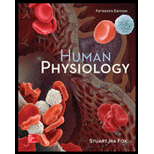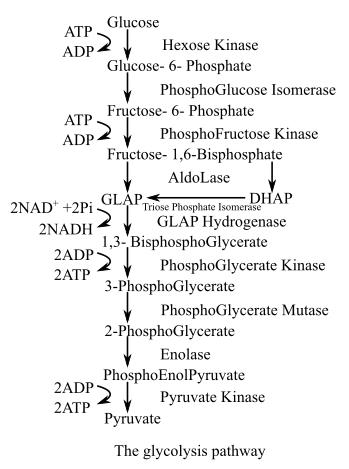
Define the term glycolysis in terms of its initial substrates and products. Explain why there is a net gain of 2 molecules of ATP in this process.
To review:
The definition of glycolysis in terms of its initial substrates and products along with the reason for the net gain of two molecules of ATP in the process.
Introduction:
Cellular respiration is a process in which energy is released by stepwise break down of glucose and other molecules through which energy is consumed, and some of this energy is used to produce ATP (adenosine triphosphate), that is, the energy currency for every cell. The complete combustion of a glucose molecule requires oxygen and yields about 38 ATP for each molecule of glucose. Some of the energy is produced in the absence of an oxygen requiring pathway that leads to the generation of lactic acid as an end product.
Explanation of Solution
The first cellular respiration process for the breakdown of glucose is glycolysis, which is a process of breakdown of glucose (a 6-carbon compound) into the two molecules of pyruvate or pyruvic acid (a 3-carbon compound). The diagram belowshows the different steps in the breakdown of glucose:

Glycolysis is a 10-step process and in every step, enzymes are required to catalyze the reaction. The 6-carbon molecule is the substrate which results in the production of two molecules of 3-carbon pyruvic acid (pyruvate).
The pathway requires two ATP molecules as a source of energy, one for the conversion of glucose into glucose-6-phosphate and the second for the conversion of fructose-6-phosphate into the fructose-1,6-bisphosphate.
The glycolysis pathway generates 2 molecules of NADH (nicotinamide adenine dinucleotide hydrogen) and 4 molecules of ATP, 2 ATP molecules are expended during the process, so there is a net gain of 2 ATP molecules.
Want to see more full solutions like this?
Chapter 5 Solutions
Human Physiology
- Describe the principle of homeostasis.arrow_forwardExplain how the hormones of the glands listed below travel around the body to target organs and tissues : Pituitary gland Hypothalamus Thyroid Parathyroid Adrenal Pineal Pancreas(islets of langerhans) Gonads (testes and ovaries) Placentaarrow_forwardWhat are the functions of the hormones produced in the glands listed below: Pituitary gland Hypothalamus Thyroid Parathyroid Adrenal Pineal Pancreas(islets of langerhans) Gonads (testes and ovaries) Placentaarrow_forward
- Describe the hormones produced in the glands listed below: Pituitary gland Hypothalamus Thyroid Parathyroid Adrenal Pineal Pancreas(islets of langerhans) Gonads (testes and ovaries) Placentaarrow_forwardPlease help me calculate drug dosage from the following information: Patient weight: 35 pounds, so 15.9 kilograms (got this by dividing 35 pounds by 2.2 kilograms) Drug dose: 0.05mg/kg Drug concentration: 2mg/mLarrow_forwardA 25-year-old woman presents to the emergency department with a 2-day history of fever, chills, severe headache, and confusion. She recently returned from a trip to sub-Saharan Africa, where she did not take malaria prophylaxis. On examination, she is febrile (39.8°C/103.6°F) and hypotensive. Laboratory studies reveal hemoglobin of 8.0 g/dL, platelet count of 50,000/μL, and evidence of hemoglobinuria. A peripheral blood smear shows ring forms and banana-shaped gametocytes. Which of the following Plasmodium species is most likely responsible for her severe symptoms? A. Plasmodium vivax B. Plasmodium ovale C. Plasmodium malariae D. Plasmodium falciparumarrow_forward
- please fill in missing parts , thank youarrow_forwardplease draw in the answers, thank youarrow_forwarda. On this first grid, assume that the DNA and RNA templates are read left to right. DNA DNA mRNA codon tRNA anticodon polypeptide _strand strand C с A T G A U G C A TRP b. Now do this AGAIN assuming that the DNA and RNA templates are read right to left. DNA DNA strand strand C mRNA codon tRNA anticodon polypeptide 0 A T G A U G с A TRParrow_forward
 Concepts of BiologyBiologyISBN:9781938168116Author:Samantha Fowler, Rebecca Roush, James WisePublisher:OpenStax College
Concepts of BiologyBiologyISBN:9781938168116Author:Samantha Fowler, Rebecca Roush, James WisePublisher:OpenStax College Human Physiology: From Cells to Systems (MindTap ...BiologyISBN:9781285866932Author:Lauralee SherwoodPublisher:Cengage Learning
Human Physiology: From Cells to Systems (MindTap ...BiologyISBN:9781285866932Author:Lauralee SherwoodPublisher:Cengage Learning BiochemistryBiochemistryISBN:9781305577206Author:Reginald H. Garrett, Charles M. GrishamPublisher:Cengage Learning
BiochemistryBiochemistryISBN:9781305577206Author:Reginald H. Garrett, Charles M. GrishamPublisher:Cengage Learning
 Human Heredity: Principles and Issues (MindTap Co...BiologyISBN:9781305251052Author:Michael CummingsPublisher:Cengage Learning
Human Heredity: Principles and Issues (MindTap Co...BiologyISBN:9781305251052Author:Michael CummingsPublisher:Cengage Learning





